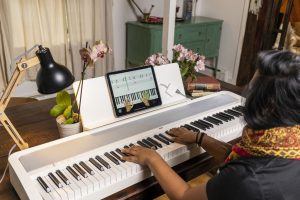The piano and synthesizer are two of the most iconic and versatile instruments in music, each with a unique role in shaping modern sound. However, they differ in many ways.
This article will highlight the key differences between a synthesizer vs piano, helping you decide which one suits your musical needs better.
- Fall in love with the music - Learn your favorite songs, at a level suitable for you.
- Enjoy interactive piano lessons - Explore courses covering music theory, technique chords & more.
- Get real-time feedback - Skoove's feedback tells you what went well and what needs practice.

What is a synthesizer?
Synthesizers come in various forms, including analog, digital, and hybrid models, each offering unique features and capabilities. At its most basic level, a synthesizer is an electronic musical instrument that generates audio signals. These signals can be shaped and modulated to produce a wide variety of sounds, mimicking traditional instruments or creating entirely new sounds that have no acoustic counterpart.
Synthesizers consist of several key components, each playing a vital role in sound production. Oscillators are responsible for generating the raw audio signals, while filters shape the sound by removing certain frequencies.
What is a piano?
The history of the piano dates back to the early 18th century, invented by Bartolomeo Cristofori in Italy. It evolved from earlier keyboard instruments like the harpsichord and clavichord, offering greater dynamic range and expressive capabilities.
The piano produces sound through strings struck by hammers. It has 88 keys, covering a broad range of notes, and is known for its expressive range and dynamic capabilities. When a key is pressed, it triggers a mechanism that causes a hammer to strike the corresponding string, creating a vibration that produces sound. The piano pedals at the base of the piano allow the player to modify the sound, such as sustaining notes or softening the volume.
Difference between synthesizer and piano
The differences between a synthesizer and a piano are profound, affecting how they are played, the sounds they produce, the different concepts of sound on each instrument, and their applications in music.
Sound production
The piano produces sound acoustically through the physical action of hammers striking strings, whereas the synthesizer generates sound electronically. This fundamental difference in sound production results in distinctive characteristics for each instrument.
The piano’s sound is rich and organic, with a natural resonance that can vary depending on the instrument’s construction and the player’s technique. In contrast, the synthesizer’s sound can be manipulated in countless ways, allowing for a vast array of tones and effects that are impossible to achieve with a traditional piano.
Applications in music
The piano is widely used in classical, jazz, pop, and many other genres, often featured as a solo instrument or part of an ensemble. Its rich, full sound provides a solid foundation for compositions and performances.
The synthesizer, prominent in electronic music, pop, rock, and experimental genres, is valued for its unique sounds and capabilities in sound design. It can create everything from realistic instrument emulations to entirely new sonic textures, making it a versatile tool in modern music production.
In this YouTube video, you can learn more about the differences between pianos, keyboards, and synthesizers.
Sound variety
While the piano is limited to the natural sound of its strings and soundboard, the synthesizer offers an almost limitless range of sounds. A piano’s variations come from the player’s touch and use of pedals, whereas a synthesizer can mimic traditional instruments, produce entirely synthetic tones, and create complex soundscapes. This versatility makes the synthesizer a favorite among electronic musicians and sound designers.
Learning curve
Learning to play the piano involves understanding music theory, developing finger strength and dexterity, and practicing complex pieces. The piano’s layout and the need for hand independence add to the challenge.
Synthesizers, while potentially easier to start with, can become complex when delving into sound design and programming. Mastering a synthesizer involves understanding its various components and how they interact, as well as learning to use modulation and other advanced features.
Expression and dynamics
The piano is renowned for its expressive range, allowing for nuanced dynamics and emotional depth in performance. The player’s touch can vary the volume and tone of each note, creating a wide range of expressive possibilities.
Synthesizers, while capable of expression, often rely on additional controls like modulation wheels, aftertouch, and velocity sensitivity to achieve similar dynamics in music. These features allow synthesizer players to add expression to their performances, but the feel and response differ from the acoustic piano.
Historical context
The piano’s history dates back to the early 18th century, with Bartolomeo Cristofori’s invention marking a significant milestone in the evolution of keyboard instruments. Throughout the 19th and 20th centuries, the piano’s design and construction continued to evolve, leading to the modern grand and upright pianos we know today. Its role in classical music, jazz, and contemporary genres has solidified its status as a foundational instrument in Western music.
Synthesizers have a rich history, with early models dating back to the mid-20th century. The first commercially available synthesizer, the Moog, was introduced in the 1960s by Robert Moog. This marked the beginning of a new era in music, where electronic sounds became increasingly prominent. Some modern synths are even making use of AI in music.
Playing techniques
Playing the piano requires a combination of technical skill, musical knowledge, and physical coordination. Pianists must develop finger strength and dexterity to navigate the keyboard’s 88 keys. Pedaling techniques add another layer of complexity, allowing for sustained notes, softer tones, and other expressive effects.
In contrast, playing a synthesizer involves a different set of skills. While basic use can be straightforward, advanced techniques require an understanding of sound design and synthesis. Synthesizer players must learn to manipulate oscillators, filters, and other components to create and modify sounds.
Cost considerations
The cost of owning a piano can be significant, with high-quality grand pianos often commanding prices in the tens of thousands of dollars. Upright pianos are more affordable but still represent a substantial investment. Additionally, pianos require regular tuning and maintenance, adding to the overall cost of ownership.
Synthesizers, on the other hand, offer a broader range of price points. Entry-level models can be quite affordable, while high-end professional synthesizers can also be expensive. Synthesizers often require additional equipment, such as amplifiers, speakers, and sometimes computers and software, depending on their use.
Integration in modern music
Pianos and synthesizers each hold unique places in modern music. The piano’s rich, acoustic sound continues to be a cornerstone in many genres, providing a foundation for compositions and performances. Pop and rock music frequently feature pianos, particularly in ballads and foundational arrangements. In jazz, the piano remains a central instrument, known for its improvisational capabilities. Classical music heavily relies on the piano for both solo and orchestral compositions.
Synthesizers, with their vast sound palette and versatility, have become essential in genres like electronic music, film scoring, and contemporary pop. Electronic music genres such as EDM, trance, and house music are built around synthesizers, which provide the driving beats and complex soundscapes characteristic of these styles.
Tips for success
For piano players:
- Practice regularly: Consistent practice is key to developing your skills and improving your playing. Setting aside dedicated practice time each day can lead to significant progress.
- Learn music theory: Understanding music theory can enhance your ability to read music, improvise, and compose. It provides a solid foundation for all aspects of musical performance.
- Explore different genres: Experimenting with various genres can broaden your musical horizons and improve your versatility. Playing different styles can also keep practice sessions engaging and enjoyable.
For synthesizer players:
- Understand your instrument: Take the time to learn about the different components and functions of your synthesizer. Familiarity with your instrument’s capabilities can greatly enhance your sound design skills.
- Experiment with sound design: Don’t be afraid to experiment with creating and modifying sounds. Exploring new possibilities can lead to unique and innovative music.
- Use resources: Utilize online tutorials, forums, and communities to learn new techniques and get the most out of your synthesizer. There is a wealth of information available to help you expand your knowledge and skills.
Synthesizer vs piano combined: the best of both worlds!
The choice between a synthesizer vs piano ultimately depends on your musical goals and the kind of sound you want to create. A piano offers rich, acoustic tones and is perfect for classical, jazz, and traditional genres. It allows for expressive dynamics and a deep connection to the music.
On the other hand, a synthesizer opens up an expansive world of digital sound design, letting you experiment with electronic tones, effects, and genres like EDM, pop, and ambient music.
Understanding the differences between a synthesizer vs piano, and reflecting on your musical style, will help you choose the right instrument for your creative journey. Whichever path you choose, learning to play can be an exciting and fulfilling experience.
Author of this blog post:
Susana Pérez Posada

With over seven years of piano education and a deep passion for music therapy, Susana brings a unique blend of expertise to Skoove. A graduate in Music Therapy from SRH Hochschule Heidelberg and an experienced classical pianist from Universidad EAFIT, she infuses her teaching with a holistic approach that transcends traditional piano lessons. Susana’s writings for Skoove combine her rich musical knowledge with engaging storytelling, enriching the learning experience for pianists of all levels. Away from the piano, she loves exploring new places and immersing herself in a good book, believing these diverse experiences enhance her creative teaching style.
Published by Lydia Ogn from the Skoove team















